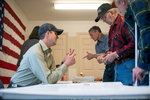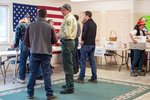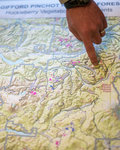



PACKWOOD — Ask the average Joe what’s wrong in the wild world of huckleberries these days and you’re likely to get a long, blank stare.
That’s why the Pinchot Partners organized an open house in Packwood last week in order to spread the word about the forces at work against the sweet nature, and historic abundance, of the summer forest delicacies.
As it turns out, huckleberries need a little bit of assistance from either nature or human hands in order to thrive among the dense thickets of forest that blanket the Cascade foothills. Namely, huckleberries require plenty of open canopy space in order to grow and ripen. Over the last 120 years, a combination of changing logging practices and increased fire suppression has created a forest that is choking out the once common huckleberry.
“Native Americans used to do burning to keep areas open and even logging helped,” explained Jamie Tolfree, coordinator for the Pinchot Partners. “The habitat is encroaching, bottom line.”
As the forest came under control of the U.S. Forest Service and logging operations began to dwindle, the forest grew denser. During that same time, Native Americans lost their right to conduct the controlled burns that cleared the underbrush where huckleberry bushes grow, and increasingly aggressive wildfire suppression efforts have prevented the natural thinning of timber stands.
John Squires, treasurer for the Pinchot Partners, says he’s been an eyewitness over the last few decades as formerly prime huckleberry habitat has begun to wither.
“I can remember being purple handed and purple faced and bringing my dad not very many huckleberries because most of them went in my mouth,” said Squires with a smile.
Squires used to regularly go picking up at the Midway Guard Station. Now, he says the terrain is covered in trees too thick to let the sun shine through.
“You see the meadows just getting smaller and smaller,” said Squires, who estimates that about three-quarters of the huckleberry habitat in the Gifford Pinchot National Forest has been lost over the past 50 years or so. “We feel that if we’re not proactive and manage it appropriately it will disappear.”
In spite of the changing landscape, Squires still goes picking, but the task is much more difficult than before. He says he prefers to look in old clearcuts, but refused to divulge much more information than that. It seems huckleberry gatherers are as protective of their prime spots as golddiggers and mushroom pickers.
“I’ll never tell you where I go picking,” said Squires. “That’s proprietary information.”
Squires said prime huckleberry season usually stretches from the end of July to the end of September, and amateur huckleberry hounds like himself don’t need a permit to go picking so long as they pick no more than 1 gallon per day or 3 gallons in a year. With huckleberries selling upwards of $30 per pound these days, Squires says that the health of their habitat is vital to the economy of Lewis County and other rural counties in Washington. He noted that huckleberries have never been domesticated, and commercial huckleberry harvesting permits typically sell out within two hours when they go on sale.
After identifying the need to address the huckleberry problem eight years ago, the first hands-on huckleberry management efforts that the Pinchot Partners were involved in began about four years later. Those efforts include commercial logging of tall timbers and non-commercial cuts intended to clear out spindly trees and thick underbrush. The Pinchot Partners hope to monitor those sites as long as possible in order to study how those clearing efforts help to bring bright blue, purple and orange berries back to the landscape.
Another economic benefit of concerted huckleberry management is that it creates timber jobs within Lewis County, and the ensuing tax dollars are returned directly to services and projects within the county.
“It’s sometimes hard to tell people that we need to cut trees down to promote huckleberries because some people have a kneejerk reaction that cutting trees is always bad,” said Squires.
Squires said the partnership with the U.S. Forest Service has been imperative to the success of habitat restoration efforts so far.
“Instead of being adversaries with the Forest Service we’ve created a nice collaborative environment with them,” Squires said.
Chris Starling, of the USFS, said huckleberry habitat management fits in well with his day-to-day goals and long-term vision for the forest.
“For me it’s an interconnected approach. It’s for the benefit of all forest products,” said Starling, who mentioned wildlife, bear grass, timber stand health and continued public access as a smattering of the variables that he takes into account when deciding where to focus habitat rehabilitation efforts.
Cowlitz Valley District Ranger for the USFS, Gar Abbas, agreed with Starling’s assessment, noting, “We want to accommodate as much as we can within the ecosystem we have.”
David Stepetin, of the Nisqually Tribe, was on hand at the open house and came prepared with gifts of smoked salmon and frozen huckleberries for all visitors. He says that the effort to restore huckleberry habitat to the Cascade foothills is a natural endeavor for the tribes to be involved with.
“It’s essential to our heritage, our cultural and ancestral values,” said Stepetin.
Drawing the connection between the gifts that he eagerly handed out at the openhouse, Stepetin noted that strong salmon runs that used to reach high up into the hills helped to build the nutrient rich soils of Washington’s forests that supported those huckleberry stands through the natural cycle of spawning and death. Nowadays it will take a more focused approach from humans to try to overcome a plethora of obstacles of our own creation.
“My hope is to get our young people involved in getting salmon enhanced soil to bring up and feed the huckleberries,” said Stepetin.
At Wednesday’s open house at the fire station in Packwood, there were tables set up to discuss the intricacies of GIS mapping and field verification of huckleberry hotspots, field monitoring of known huckleberry habitat as well as recently improved areas, general huckleberry gathering, and volunteer signups for community huckleberry restoration efforts. The event was sponsored by the Weyerhaeuser Family Foundation and was intended to serve as a pilot program of sorts for similar efforts around the region.
“Our goal was to educate people about what we are doing and to get their feedback if they know of a better place to go,” said Tolfree, from the Pinchot Partners.
The Pinchot Partners are planning a huckleberry field trip open to the public on Aug. 10. The preliminary plan is for attendees, who should bring a bucket for huckleberry gathering, to meet up at the Cowlitz Valley Ranger Station at 9 a.m. Additional information on the Pinchot Partners can be found online at www.pinchotpartners.org. Jamie Tolfree can be reached by phone at 360-334-2555.